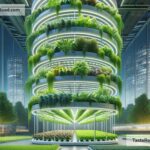The Future of Food and Regenerative Systems: A Path Toward Healthier People and Planet
Food is at the heart of human life. It’s what fuels us, connects us, and keeps us going every day. But the way we grow, produce, transport, and consume food has a big impact on the planet. The future of food is about much more than taste and nutrition—it’s about building a system that helps both people and the Earth thrive. One of the most promising ideas shaping the future of food is regenerative systems.
What Are Regenerative Systems?
Regenerative systems are approaches to farming and food production that focus on restoring and improving the land, water, and ecosystems. Unlike traditional farming methods, which often damage the environment and deplete natural resources, regenerative farming works with nature instead of against it. This means adopting practices that improve soil health, recycle nutrients, reduce waste, and support biodiversity.
Simply put, regenerative systems are about giving back to the Earth what we take from it—and sometimes even more.
Why Do We Need Regenerative Systems?
The current food system is facing big challenges. Industrial agriculture, which relies heavily on chemicals, monoculture crops, and factory farming, has led to soil degradation, pollution, deforestation, and loss of wildlife. At the same time, climate change is making it harder for farmers to grow food, with more droughts, floods, and extreme weather events.
As the global population grows and demands for food increase, we need to rethink how we produce food. The goal isn’t just to make enough for everyone—it’s to do it in a way that protects the planet and secures food for future generations.
What Does Regenerative Farming Look Like?
Regenerative farming includes practices that help maintain healthy ecosystems. Here are some key features:
-
Healthy Soil: Farmers focus on building and maintaining soil health by using techniques like composting, crop rotation, cover crops, and reduced tilling. Healthy soil stores carbon (helping fight climate change), holds water better, and produces more nutritious food.
-
Biodiversity: Instead of planting just one crop over vast areas, regenerative farming encourages growing multiple crops and integrating animals like chickens or cows into the system. More biodiversity means fewer pests, healthier ecosystems, and greater resilience to changes in weather.
-
Minimal Use of Chemicals: Regenerative systems avoid harmful pesticides and fertilizers. Instead, they use natural methods to keep pests under control and fertilize the soil.
-
Water Conservation: Many regenerative farms use rainwater-harvesting techniques, efficient irrigation systems, or methods that prevent runoff to lessen water usage and protect rivers, lakes, and oceans.
-
Circular Systems: Waste from the farm—like animal manure or food scraps—is reused to improve soil instead of being thrown away.
How Can Regenerative Systems Help Us?
-
Better Food Quality: Food grown in healthy soil often has more nutrients, meaning healthier meals for people. Regenerative farming also avoids harmful chemicals, making food safer.
-
Combat Climate Change: Regenerative systems can help draw carbon out of the air and store it in the soil. This can reduce greenhouse gases and slow climate change.
-
Stronger Biodiversity: By protecting wildlife habitats, regenerative farms support a wide variety of plants, insects, and animals.
-
Healthier Communities: Regenerative farming often supports small-scale farmers and helps local economies thrive.
-
Resilience: Farms that work with nature are better equipped to handle challenges such as extreme weather, pests, and diseases.
Moving Beyond Farming: Regenerative Food Systems
Regenerative food systems go beyond the farm. They include how food is transported, processed, sold, and consumed in ways that reduce waste and improve sustainability. For example, companies and grocery stores are beginning to adopt circular systems to recycle packaging or use leftover produce as ingredients for other products.
Consumers also play a role in regenerative food systems. By making thoughtful choices—such as buying local produce, supporting farmers practicing sustainable methods, and reducing food waste—we can help create a better future for food.
Challenges and Opportunities
Adopting regenerative systems isn’t easy. Farmers may need training and tools to switch from traditional methods to regenerative practices. These changes can be costly and take time. Governments and businesses must support farmers by offering incentives, funding, and education.
Additionally, consumers can help drive demand for regeneratively grown food. When people actively choose food that’s grown sustainably, supermarkets, food brands, and restaurants will follow suit.
Despite the challenges, there are many opportunities. Regenerative systems can spark innovation in the food industry, create new jobs, and inspire people to care for the planet. Around the world, farmers, scientists, entrepreneurs, and activists are already working together to create a healthier food system.
A Hopeful Future for Food
Imagine a world where the food we eat not only nourishes us but also heals the Earth. Regenerative systems offer us a way to grow food that’s kind to the planet, supports farmers, and makes life better for future generations.
The shift to regenerative food systems requires teamwork, creativity, and a willingness to change. But with every small step—whether it’s a farmer planting cover crops or a shopper choosing locally grown veggies—we can move closer to a future where food sustains not just humans, but the planet itself.
The future of food is regenerative. And it’s up to all of us to help make that future a reality.


